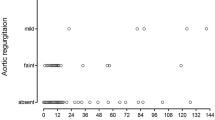Abstract
According to current short-term evidence, ventricular septal defect (VSD) closure should be performed as early as possible after aortic regurgitation (AR) diagnosis in pediatric patients to prevent AR progression. However, long-term follow-up data are lacking. Therefore, our aim was to evaluate the long-term follow-up (≥ 10 years) of patients who underwent VSD closure as early as possible after AR diagnosis and to evaluate whether early VSD closure prevents progression of AR. This was a retrospective cohort study of 42 patients with VSD and AR who had undergone VSD closure at a median age of 2.9 years, with a median waiting period from AR diagnosis to VSD closure of 3.4 months and follow-up of a median 13.1 years (interquartile range 10.0–15.8 years). The preoperative degree of AR was trivial in 25 patients, mild in 15, and moderate in 2. Of the 33 patients followed up for ≥ 10 years, none required aortic valve replacement and there was no incidence of mortality. The degree of AR improved or did not change, except in 1 patient. The size of the VSD (odds ratio [OR] 0.85; 95% confidence interval [CI] 0.62–1.18; p = 0.33), time from diagnosis to surgery (OR 1.00; 95% CI 1.000–1.001; p = 0.657), and age at the time of surgery (OR 1.00; 95% CI 0.998–1.004; p = 0.452) were not predictive of persistent postoperative AR. Therefore, VSD closure performed as early as possible after AR diagnosis could successfully prevent AR progression in patients with less than moderate preoperative AR, eliminating the need for aortic valve replacement and valvuloplasty.

Similar content being viewed by others
References
Eroğlu AG, Oztunç F, Saltik L et al (2003) Aortic valve prolapse and aortic regurgitation in patients with ventricular septal defect. Pediatr Cardiol 24:36–39
Glen S, Burns J, Bloomfield P (2004) Prevalence and development of additional cardiac abnormalities in 1448 patients with congenital ventricular septal defects. Heart 90:1321–1325
Tatsuno K, Konno S, Ando M et al (1973) Pathogenetic mechanisms of prolapsing aortic valve and aortic regurgitation associated with ventricular septal defect. Anatomical, angiographic, and surgical considerations. Circulation 48:1028–1037
Tweddell JS, Pelech AN, Frommelt PC (2006) Ventricular septal defect and aortic valve regurgitation: pathophysiology and indications for surgery. Semin Thorac Cardiovasc Surg Pediatr Card Surg Annu 9:147–52
Jung H, Cho JY, Lee Y (2019) Progression of aortic regurgitation after subarterial ventricular septal defect repair: optimal timing of the 0peration. Pediatr Cardiol 40:1696–1702
Chiu SN, Wang JK, Lin MT et al (2007) Progression of aortic regurgitation after surgical repair of outlet-type ventricular septal defects. Am Heart J 153:336–342
Cheung YF, Chiu CS, Yung TC, Chau AK (2002) Impact of preoperative aortic cusp prolapse on long-term outcome after surgical closure of subarterial ventricular septal defect. Ann Thorac Surg 73:622–627
Kostolny M, Schreiber C, von Arnim V et al (2006) Timing of repair in ventricular septal defect with aortic insufficiency. Thorac Cardiovasc Surg 54:512–515
Elgamal MA, Hakimi M, Lyons JM et al (1999) Risk factors for failure of aortic valvuloplasty in aortic insufficiency with ventricular septal defect. Ann Thorac Surg 68:1350–1355
Ishikawa S, Morishita Y, Sato Y et al (1994) Frequency and operative correction of aortic insufficiency associated with ventricular septal defect. Ann Thorac Surg 57:996–998
Lun K, Li H, Leung MP et al (2001) Analysis of indications for surgical closure of subarterial ventricular septal defect without associated aortic cusp prolapse and aortic regurgitation. Am J Cardiol 87:1266–1270
Sim EK, Grignani RT, Wong ML et al (1999) Outcome of surgical closure of doubly committed subarterial ventricular septal defect. Ann Thorac Surg 67:736–738
Devlin PJ, Russell HM, Mongé MC et al (2014) Doubly committed and juxtaarterial ventricular septal defect: outcomes of the aortic and pulmonary valves. Ann Thorac Surg 97:2134–2140 (discussion 2140–1)
Komai H, Naito Y, Fujiwara K et al (1997) Surgical strategy for doubly committed subarterial ventricular septal defect with aortic cusp prolapse. Ann Thorac Surg 64:1146–1149
Kale SB, Finucane K, Chan TL et al (2010) Midterm results of repair of perimembranous or conal ventricular septal defects using the transaortic direct suture technique. Ann Thorac Surg 89:1244–1249
Salih HG, Ismail SR, Kabbani MS et al (2016) Predictors for the outcome of aortic regurgitation after cardiac surgery in patients with ventricular septal defect and aortic cusp prolapse in Saudi patients. Heart Views 17:83–87
Amano M, Izumi C, Imamura S et al (2016) Progression of aortic regurgitation after subpulmonic infundibular ventricular septal defect repair. Heart 102:1479–1484
Padiyath A, Makil ES, Braley KT et al (2017) Frequency of development of aortic valve disease in unrepaired perimembranous ventricular septal defects. Am J Cardiol 119:1670–1674
Lopez L, Houyel L, Colan SD et al (2018) Classification of ventricular septal defects for the eleventh iteration of the International Classification of Diseases—Striving for Consensus: a report from the International Society for Nomenclature of Paediatric and Congenital Heart Disease. Ann Thorac Surg 106:1578–1589
Omoto R, Yokote Y, Takamoto S et al (1984) The development of real-time two-dimensional Doppler echocardiography and its clinical significance in acquired valvular diseases. With special reference to the evaluation of valvular regurgitation. Jpn Heart J 25:325–40
Acknowledgements
We thank all infants and parents, doctors, and medical staff involved in this study.
Funding
This research received no grant from any funding agency in the public, commercial or not-for-profit sectors.
Author information
Authors and Affiliations
Contributions
GS: Conceptualization, Methodology, Formal analysis, Investigation, Writing-original draft, Project administration. KO: Supervision, Writing-review & editing. HS: Visualization, Writing-review & editing. ST: Visualization, Writing-review & editing.
Corresponding author
Ethics declarations
Conflict of interest
The authors have no conflicts of interest to declare.
Additional information
Publisher's Note
Springer Nature remains neutral with regard to jurisdictional claims in published maps and institutional affiliations.
Previous presentation: The information presented in this study has not been published, in part or in entirety.
Rights and permissions
About this article
Cite this article
Sotodate, G., Oyama, K., Saiki, H. et al. Early Ventricular Septal Defect Closure Prevents the Progression of Aortic Regurgitation: A Long-Term Follow-Up Study. Pediatr Cardiol 42, 1607–1613 (2021). https://doi.org/10.1007/s00246-021-02647-5
Received:
Accepted:
Published:
Issue Date:
DOI: https://doi.org/10.1007/s00246-021-02647-5




